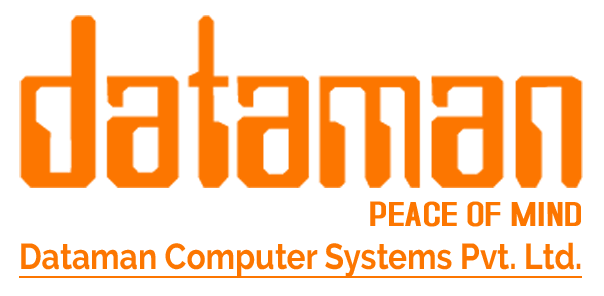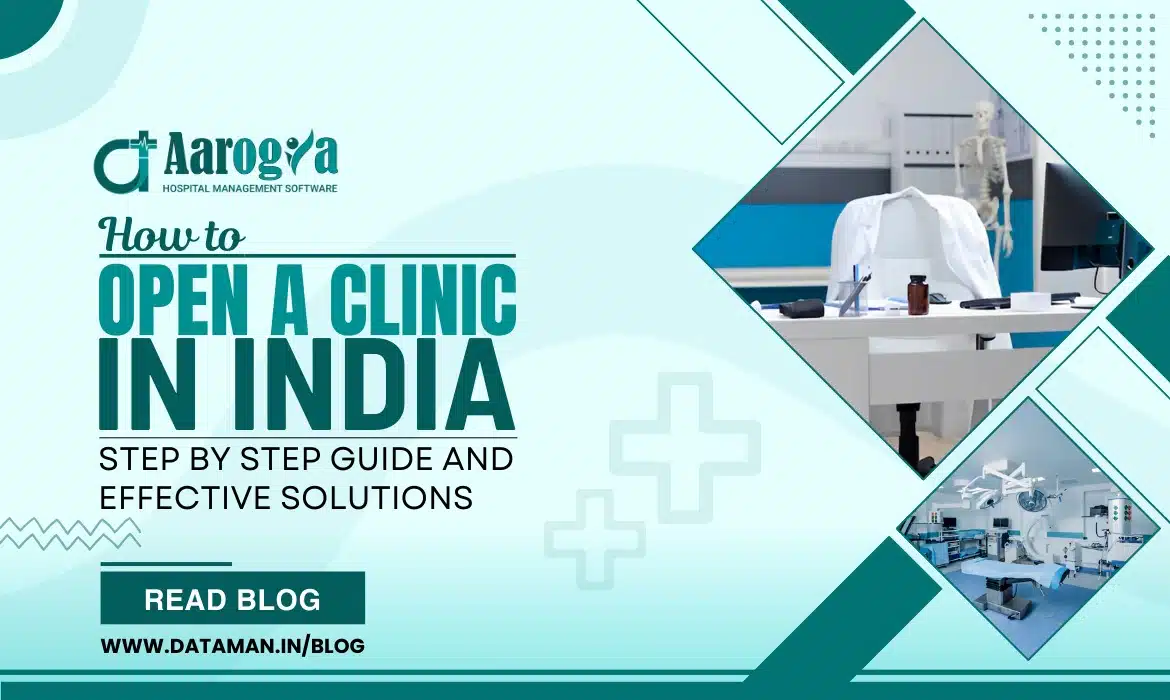- +91 9511117684
- shweta@dataman.in
How Medicines Are Made: Inside Pharmaceutical Manufacturing Process
Introduction
How Medicines Are Made: Ever wondered how the tiny pill you take for a headache or the syrup your doctor prescribes is actually made? Medicine production, or pharmaceutical manufacturing, is a meticulous journey that begins with an idea and ends with a life-saving product on the shelf.
In this blog, we break down how medicine is made, what regulations govern its development, and how modern solutions like pharmacy production software are transforming pharmaceutical manufacturing.
Tools like Dm Aarogya are streamlining production with automation and compliance-ready modules, helping ensure efficiency and regulatory adherence in every step of the process.
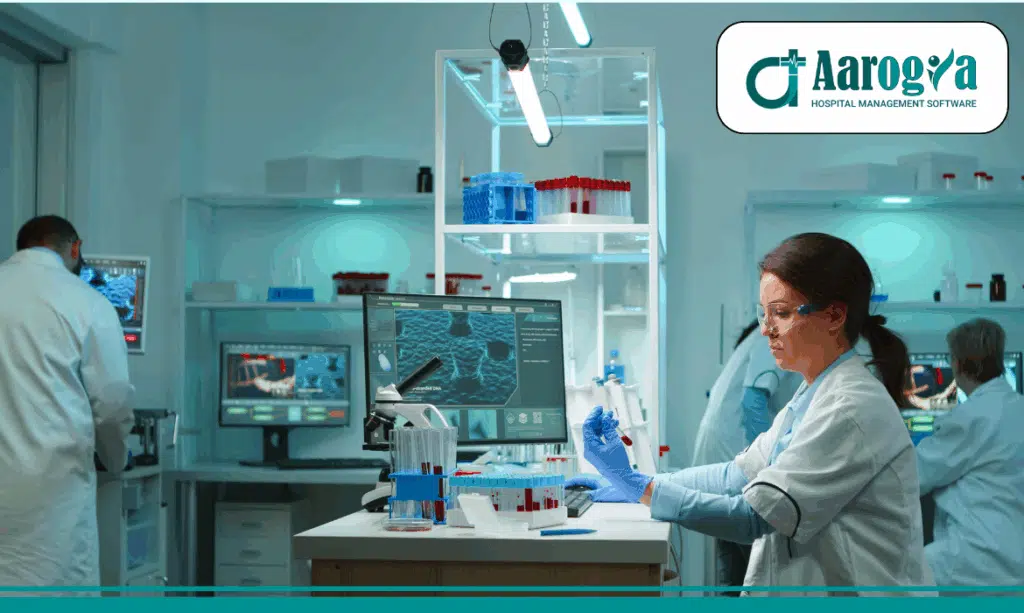
1. What is Medicine Production?
Medicine production is the science of creating pharmaceutical products in a controlled and regulated environment. Pharmaceutical manufacturing involves the industrial-scale synthesis of pharmaceutical drugs. This process is meticulously designed to ensure that medications meet stringent quality standards, ensuring their safety and efficacy.
The production process can be broadly categorized into:
- Primary Processing: Converting raw materials into active ingredients.
- Secondary Processing: Turning these active ingredients into tablets, syrups, or injectables.
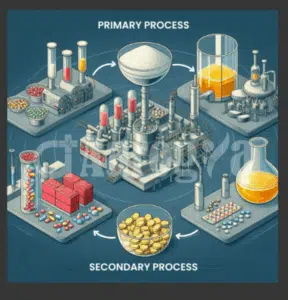
This process must comply with Good Manufacturing Practices (GMP) laid out by global and national authorities like the FDA, WHO, and CDSCO.
2. From Molecule to Market: Stages of Drug Development
1. Drug Discovery & Preclinical Research
In this phase, scientists study potential drug compounds to see if they can provide therapeutic benefits.
Preclinical testing involves lab experiments and animal testing to check the safety and effectiveness of these compounds before human trials.
2. Preclinical Research:
During preclinical research, compounds are tested in the lab and on animals to ensure they are safe and effective. This step helps determine if the compound is ready for human testing.
3. Clinical Research:
Human trials are conducted in multiple phases to evaluate the drug’s safety and efficacy.
These are typically conducted in four phases:
Phase I – Tests safety in a small group.
Phase II – Evaluates efficacy and side effects.
Phase III – Large-scale testing on diverse populations.
Phase IV – Post-market surveillance
4. FDA Review:
Comprehensive evaluation by regulatory bodies like FDA determines whether the drug can be approved for public use.
5. Post-Market Safety Monitoring:
Ongoing surveillance ensures that any long-term or rare side effects are identified and addressed.
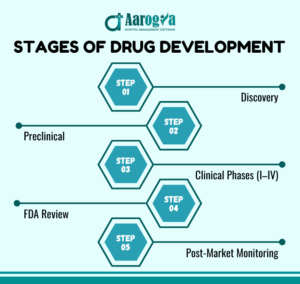
Each phase is critical to ensure that only safe and effective medications reach the market.
Read more on The Pharmaceutical Journal
3. The Manufacturing Process: Step-by-Step
Transforming active pharmaceutical ingredients into final drug products involves several precise steps:
A. Formulation
Active ingredients are combined with excipients to create a stable and effective product. This step ensures that the medication delivers the intended therapeutic effect consistently.
B. Mixing and Granulation
The blended materials are mixed thoroughly, and granulation may be performed to improve the flow and compression characteristics of powders.
C. Drying
The granulated mixture is dried to achieve the desired moisture content, which is crucial for the stability and compressibility of the final product.
D. Compression and Encapsulation
The dried granules are compressed into tablets or filled into capsules, forming the final dosage forms.
E. Coating
Tablets may be coated to protect the drug substance, mask taste, or control the release of the medication in the body.
F. Packaging and Labeling
The final products are packaged in suitable containers and labeled with essential information, ensuring compliance with regulatory standards and providing critical information to healthcare providers and patients.
Each step is governed by strict protocols to maintain the highest quality standards.
4. Quality Control and Regulatory Approvals
Strict regulatory frameworks govern pharmaceutical production. In India, compliance with GMP standards by CDSCO and the Drugs and Cosmetics Act is mandatory. Globally, the FDA , TGA (Australia), and EMA (Europe) supervise approvals.
Ensuring the safety and efficacy of pharmaceutical products is paramount. Regulatory agencies enforce CGMP to oversee manufacturing processes. Compliance with CGMP assures that drugs meet quality standards and are consistently produced and controlled.
More on how US FDA Evaluates and Ensures Compliance:
CDSCO Guidelines
- FDA Manufacturing Compliance
- TGA Manufacturing Info
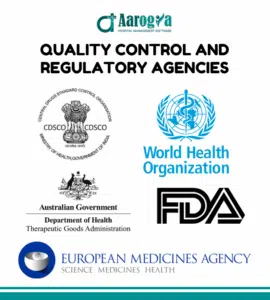
Quality Control and GMP Standards
Good Manufacturing Practices (GMP) form the backbone of the pharmaceutical world. GMP ensures that products are consistently produced and controlled according to quality standards.
Major QC Measures:
- Batch-wise testing
- In-process checks
- Final product inspection
- Storage and expiry compliance
Regulators perform random audits, and digital systems often log each batch activity, reducing the risk of manual error. FDA GMP Compliance
5. Cost Factors in Medicine Production
Developing and manufacturing pharmaceuticals is a resource-intensive endeavor influenced by various factors:
Cost Factor | Impact |
R&D | Billions in investment over years |
Clinical Trials | Human testing and documentation |
Facility Setup | Equipment, quality control labs |
Marketing & Distribution | Education, supply chain logistics |
- Research and Development (R&D): Significant investment is required to discover and develop new drugs, often involving years of research and substantial financial resources.
- Regulatory Compliance: Meeting stringent regulatory standards necessitates continuous monitoring and adaptation, incurring additional costs.
- Manufacturing Processes: Implementing advanced technologies and maintaining high-quality standards contribute to production expenses.
- Market Dynamics: Pricing strategies must balance affordability for patients and recouping investment costs, influenced by market competition and healthcare policies.
Understanding these factors is crucial for developing strategies to manage costs without compromising on quality. CRSToday
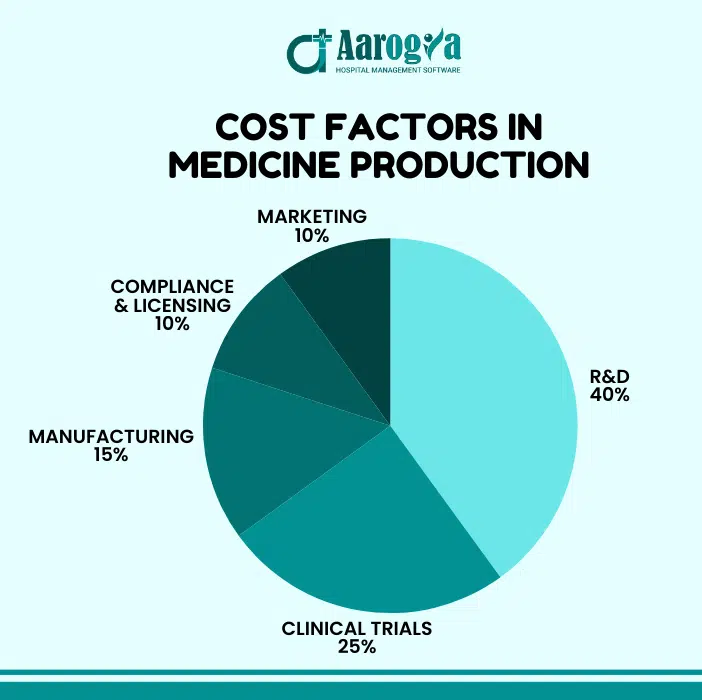
6. Pharmaceutical Manufacturing Processes
Pharmaceutical manufacturing involves several processes to produce active pharmaceutical ingredients (APIs) and formulate them into final products.
Chemical Synthesis
Chemical synthesis involves creating complex compounds from simpler substances. It’s fundamental for producing APIs, ensuring scalability, consistency, and cost efficiency. The process includes:
- Route Selection: Choosing the most efficient synthesis pathway.
- Feasibility Studies: Assessing scalability and practicality.
- Optimization: Refining reaction conditions for maximum yield and purity.
Fermentation
Fermentation uses microorganisms to produce compounds like antibiotics and vaccines. Steps include:
- Culturing: Growing microorganisms under controlled conditions.
- Scaling-Up: Expanding cultures to production volumes.
- Fermentation Process: Microorganisms convert substrates into desired products.
- Downstream Processing: Purifying and formulating the product.
This method is essential for producing complex biological products.
Bioprocessing
Bioprocessing utilizes living cells to produce therapeutic products, including monoclonal antibodies and gene therapies. It involves:
- Cell Line Development: Selecting and optimizing cells for production.
- Upstream Processing: Culturing cells and facilitating product expression.
- Downstream Processing: Harvesting, purifying, and formulating the final product.
Bioprocessing is at the forefront of developing advanced therapies.
7. Software Solutions in Pharmaceutical Production
Incorporating advanced software solutions has become essential in modern pharmaceutical manufacturing. These systems offer:
- Manufacturing Execution Systems (MES): Monitor and control production processes, ensuring efficiency and compliance.
- Quality Management Systems (QMS): Facilitate adherence to quality standards and streamline documentation.
- Enterprise Resource Planning (ERP): Integrate various business processes, enhancing coordination and decision-making.
Implementing these technologies leads to improved productivity, reduced errors, and enhanced regulatory compliance. ISPE
Future of Pharmaceutical Manufacturing
The industry is moving towards personalized medicine, AI-led formulations, and automated production.
Key Future Trends:
- 3D printing of tablets
- Smart drug packaging
- Real-time release testing
- Continuous manufacturing instead of batch-based
This future demands systems that go beyond manual registers capable of handling production templates, tracking SKUs, and auto-calculating sale and MRP rates for pharmacy-level data.
8. Tech Integration in Pharmaceutical Production
Modern pharmaceutical facilities are turning to smart manufacturing systems that ensure accuracy and compliance.
Smart Features Include:
- Batch production registers
- Auto-calculated stock and pricing
- FIFO stock tracking
- Regulatory template-based formulations
- Real-time dashboard alerts for compliance deviations
Several leading software platforms dmAarogya offer tailored solutions for pharmaceutical production units designed to reduce wastage, speed up formulation, and maintain audit-ready logs.
These tools are silently transforming how medicines are made, helping companies stay competitive and regulatory compliant.
Conclusion
Medicine production is far more than a factory process; it’s the heartbeat of global healthcare. Every capsule, syrup, or injectable is the result of years of research, strict regulatory checks, and meticulous production protocols. With rising demands for quality, speed, and transparency, pharmaceutical manufacturers must embrace smart technologies, automation, and compliance-driven software to stay ahead.
Adopting advanced solutions like dmAarogya in your production process can ensure minimal wastage, real-time quality tracking, regulatory readiness, and cost-effective operations.
Remember, efficient medicine production saves time, money and most importantly, lives.
Also Read: How to Open a Clinic in India: A Doctor’s Step-by-Step Guide
FAQ’s
1. What are the basic raw materials used in medicine production?
APIs (Active Pharmaceutical Ingredients), excipients (binders, preservatives, etc.), solvents, and packaging materials like blister foils or bottles.
2. What is the difference between API and formulation in pharma?
API is the core active compound that treats the condition, while formulation includes the API + excipients to create the final drug product.
3. How is medicine quality tested before release?
Through analytical lab tests, stability studies, microbial analysis, dissolution profiling, and final batch quality checks as per pharmacopeia standards.
4. Is automation common in pharmaceutical manufacturing?
Yes. Automation improves accuracy, reduces human error, and ensures traceability from raw material intake to final packaging.
5. Can digital software help with regulatory audits?
Absolutely. Software tools maintain audit trails, batch logs, compliance checklists, and auto-generate reports aligned with CDSCO, WHO-GMP, and FDA guidelines.
6. How is medicine tracked after production?
Through barcoding, serialization, and integrated software that enables real-time inventory tracking and counterfeit prevention.
How to Open a Clinic in India: A Doctor’s Step-by-Step Guide
Starting your own clinic is one of the most empowering steps in your medical career. It’s not just about independence it’s about creating a space where you provide care on your terms. The process can be Challenging But let’s face it.
How do you choose the right location? What licenses do you need? How do you manage costs without compromising on quality? Don’t worry you’re not alone. This guide will help you navigate every step from planning to execution, while sharing insights from top industry reports by PwC, McKinsey
By the end, you’ll have all the tools and tips you need to launch your dream clinic in India. Let’s dive in!
Why Opening a Clinic is a Smart Move
Opening a clinic is a smart move as it ensures steady income, builds a personal brand, and establishes trust in the community. It offers independence, long-term growth, and the chance to provide personalized care. With rising healthcare demand, a clinic is both a noble pursuit and a profitable investment.
Your team is efficient, your operations run smoother, and your services personalized. Sounds amazing, right? That’s the dream of every doctor stepping into private practice.
What does a Clinic Offer You?
Freedom: Your practice, your rules.
Connection: Build meaningful relationships with patients.
Scalability: Start small and expand as you grow.
But like any dream, it comes with challenges. So, let’s tackle those first.
5 Effective Solutions to overcome the challenges in opening a Clinic in India
1. Healthcare Partnerships for Better Care
Specialists like paediatricians and gynaecologists or cardiologists and endocrinologists create impactful collaborations, addressing conditions holistically. From mental health to chronic diseases, partnerships like psychiatrists with psychologists or oncologists with radiologists enhance patient outcomes.
2. Legal and Professional Guidance
Consult a healthcare lawyer or experienced mentors to navigate legalities and avoid pitfalls.
3. Leverage Compliance Tools
Invest in healthcare software like dmAarogya for seamless record keeping, audits, and meeting ABDM guidelines.
4. Controlling Cost without compromising Quality
While clinics are generally more affordable than hospitals, the initial setup costs can still seem challenging, including expenses for medical equipment, office furniture, salaries, and more.
Begin by educating yourself. Prioritize essential items like diagnostic equipment and patient seating. As your revenue increases, you can gradually expand your services.
10 Key steps to Set up Your Clinic Successfully
Step 1: Have a Business Plan
Why is a Business Plan Important?
A business plan is the foundation for starting your clinic in India. It provides a roadmap for your clinic’s vision, finances, and operations.
1. Clarity of Vision: Clearly defines the clinic’s goals and services.
2. Financial Planning: Helps estimate the startup costs and plan for sustainable operations.
3. Risk Management: Identifies potential challenges and Strategies to address them Effectively.
4. Attracting Investment: Essential if you’re seeking funding or partnerships.
5. Strategic Growth: Provides a roadmap for future expansion and development.
Step 2:Type of Clinic Selection:
1. General Practice Clinic: A versatile care center for everyday health needs and family medicine.
2. Specialty Clinic: Focused on expert care in a specific field of medicine.
3. Walk-In Clinic: Convenient healthcare without the need for an appointment.
4. Multispecialty Clinic: Comprehensive medical services with specialists under one roof.
5. Community Health Center: Accessible care designed to serve local communities.
Step 3: Secure Financing to launch Your Clinic In India
Securing the right financial support is crucial to successfully establishing your clinic. Below are various options to help you fund your dream clinic
1. Doctor Loans
- Specialized loans designed for medical professionals to meet clinic setup costs.
- Flexible repayment options and competitive interest rates.
2. Medical Equipment Loans
- Tailored loans to purchase advanced medical equipment.
- Partner with lenders like Medical Equipment Loan to avail hassle-free financing.
3. Investors and Partnerships
- Seek private investors or strategic partners interested in healthcare startups.
- Present a solid business plan showcasing potential ROI to attract funding.
4. Startup Loans or Business Loans
- Opt for general business loans tailored for small businesses or startups.
- Look for banks and NBFCs offering competitive terms for new ventures.
5. Government Grants and Subsidies
Explore healthcare-specific grants or subsidies provided by the Indian government.
Schemes like NHM, PM–ABHIM, Start up India Initiative, CGMSE, SAMRIDH Clinic Expansion Fund, offer support to start your clinic in India
It’s advisable to visit the official websites of these schemes to get detailed information about eligibility criteria,application procedures and the extent of financial assistance available for setting up a clinic in india
Step 4: Staff Your Clinic
1. Hire Qualified Professionals
Recruit licensed doctors, nurses, and technicians with expertise relevant to your clinic’s specialty.
2. Appoint Support Staff
Employ administrative personnel for front-desk operations, billing, and record-keeping, along with maintenance staff for cleanliness and upkeep.
3. Conduct Training Programs
Provide comprehensive training on clinic protocols, patient management, and the use of medical equipment.
4. Build Strong Team Dynamics
Encourage collaboration through regular team meetings and foster a positive work culture.
5. Ensure Regulatory Compliance
Adhere to Indian healthcare regulations, including clinical establishment registration and staff certifications.
Step 5: Choose the Right Location
1. Finding the Perfect Location
The location of your clinic can make or break your business. You need to think about these at first
Accessibility: Can patients reach you easily?
Visibility: Is your clinic in a spot where people notice it?
Affordability: Is the rent or purchase cost manageable?
Solution: Choose areas with high foot traffic near residential zones or commercial hubs. Avoid highly competitive markets unless you offer a unique service.
Step 6: Get the Necessary Licenses
Compliance might feel time consuming, but it’s your legal protection. You’ll need:
Certifications and Accreditations required to open a Clinic in India
| License Name | Why It’s Important | Examples |
|---|---|---|
| Clinic Registration Certificate | Ensures legal standards for safety and quality. | A general healthcare clinic in Bengaluru. |
| Doctor’s License | Legally allows doctors to treat patients. | An ENT specialist registered with the Medical Council of India. |
| Trade License | Permits a clinic to operate as a business. | Private clinic operating in Delhi. |
Pro Tip: Keep a checklist to track renewals and deadlines.
Step 7: Set Up Your Clinic
Make your clinic welcoming, functional, and professional
Reception Area: Comfortable seating, Adequate lighting, and a friendly receptionist.
Consultation Rooms: Make sure there’s privacy. Include basic medical tools and comfortable furniture.
Medical Equipment: Start with essential tools like BP monitors, ECG machines, and basic diagnostic kits.
Step 8: Build a Reliable Team
Hire professionals who share your vision for quality healthcare.
- Nurses and assistants for clinical support.
- Administrative staff for seamless operations.
- A part-time accountant to handle finances.
Step 9: Integrate Technology
Why Your Clinic Needs Technology
Automated Documentation: No more missed deadlines for licenses or audits.
Digital Integration: Align with the ABDM effortlessly.
Telemedicine Features: Expand your reach to remote patients.
Secure Records: Keep patient information safe and accessible.
Step 10: Launch and Build Patient Trust
After integrating technology and setting up your clinic, focus on delivering exceptional patient care. Establish a trustworthy reputation by:
- Ensuring transparent communication and ethical practices.
- Building strong doctor-patient relationships.
- Collecting feedback to improve services.
- Promoting your clinic through local outreach, online platforms, and community engagement.
This final step ensures your clinic becomes a reliable healthcare destination.
Insights on Financial Costs to Open a Clinic in India (2025)
| Expense Category | Details | Estimated Cost (INR) |
|---|---|---|
| Initial Registration Costs | Licensing, certifications, and trade registration for legal operations. | ₹50,000 – ₹1,00,000 |
| Space and Infrastructure | Rent or purchase of space, interior setup, furniture, and decor. | ₹5,00,000 – ₹15,00,000 |
| Medical Equipment Investment | Tools for diagnostics, basic treatments, and lab | ₹3,00,000 – ₹10,00,000 |
| Facilities | ||
|---|---|---|
| Staffing Expenses | Hiring qualified doctors, nurses, and admin staff. Monthly recurring. | ₹1,50,000 – ₹5,00,000/month |
| Marketing & Branding Budget | Promotions via digital ads, local newspapers, and clinic signage. | ₹50,000 – ₹2,00,000 |
| Medical Equipment Investment | Tools for diagnostics, basic treatments, and lab | ₹3,00,000 – ₹10,00,000 |
Essential Steps for an Efficient Billing Process in Your Clinic
1. Choose the Right Billing Software
Streamline your clinic’s financial operations Invest in user-friendly Healthcare billing software dmAarogya automate invoicing, track payments, and manage patient accounts.
2. Provide Billing Software Training for Staff
Ensure your staff is proficient in using billing software to avoid errors and provide excellent patient service.
3. Hire Qualified Billing Professionals
Accuracy and compliance matters,Employ trained and experienced billing professionals who can ensure all transactions are correctly processed and compliant with regulations.
4. Maintain Transparency in Billing
Clearly communicate billing procedures, charges, and insurance policies to patients for a transparent and positive experience.
5. Ensure Billing Compliance with Healthcare Regulations
Stay up to date with the law- Ensure your clinic complies with Indian healthcare billing regulations to avoid legal complications and penalties.
6. Offer Multiple Payment Options
Provide multiple payment methods (cash, cards, online payment) to enhance convenience and speed up transactions.
7. Implement Automated Payment Reminders
Stay on top of collections, Use automated reminders for patients regarding outstanding balances to ensure timely payments and smooth cash flow.
8. Regularly Review Billing Processes
Regularly audit and update your billing procedures to ensure efficiency, accuracy, and adherence to the latest regulations.
Conclusion
Transform Your Dream Into Reality – Open Your Clinic Today
Starting a clinic in India is your chance to blend passion with purpose and build a trusted healthcare brand. From choosing the perfect location to integrating cutting-edge technology like telemedicine, every step counts. With the growing demand for quality healthcare, now is the time to step up and make your mark. Follow this guide, and your clinic can become a trusted name in India’s healthcare revolution.
How To Overcome The Challenges Faced By First Generation Doctors-expert Solutions
Introduction: First Generation Doctor's Journey
Are you a first-generation doctor, or know someone who is ? This article is for first-generation doctors who want to start their practice. The article explores the real challenges faced by First generation Doctors in India and provides valuable insights to overcome them.
As a first-generation doctor, you may face unique challenges that others might not fully understand. Despite years of hard work, late nights, and sacrifices, you may still feel you are likely carrying student loan debt on your own and the pressure of building a stable future without family support. Balancing work and personal life can feel overwhelming, and it’s normal to wonder, “Do I really belong here?”or “Am I good enough?”Rest assured, these feelings are common, and you’re not alone. You’ve already achieved so much, but the question remains what’s next?
If you’re dreaming of starting a private practice but aren’t sure where to begin, I’m here to help you. I can guide you step-by-step, from planning your practice to ensuring its long-term success.
First Generation Doctor in India
In India, the term “first-generation doctors” refers to individuals who are the first in their families to pursue and establish a career as a doctor. Traditionally, medical education has been a privilege of well-established, often wealthy families due to its high cost and intense competition. However, first-generation doctors are breaking these barriers and reshaping the landscape of healthcare. Their role becomes even more critical when considering a striking disparity as highlighted by PWC : 75% of doctors and healthcare infrastructure are concentrated in urban areas, while 65% of the population resides in rural regions. This urban-rural divide makes the emergence of first-generation doctors a vital step toward bridging the healthcare gap and ensuring equitable access for all.
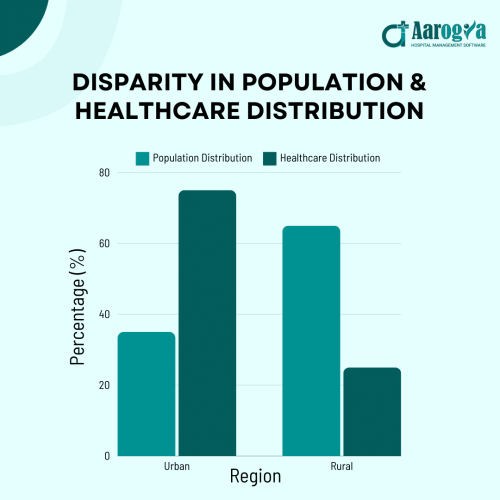
Competition and Demand for Doctors in India
India Needs Doctors Like Never Before
India has only 60 doctors per 100,000 people, significantly below the World Health Organization’s recommended 100 per 100,000. PWC WHO
India’s population is growing, and so is the need for healthcare, especially with the rise in lifestyle diseases. As a first-generation doctor, you have unique opportunities to make a mark. Whether it’s exploring underserved areas, adopting telemedicine, or specializing in something you’re passionate about, the demand is there. It’s about finding your space and using your skills where they’re needed most.
Challenges Faced by First-Generation Doctors in India Solutions to overcome them
| Challenge | Description |
|---|---|
| Financial Constraints | High medical education costs leave new doctors at significant disadvantage to start off. |
| Lack of Guidance/Mentorship | Limited access to mentorship and guidance from experienced professionals. |
| Regulatory Compliance | First-generation doctors struggle with understanding complex regulatory requirements, lacking prior experience or guidance, leading to increased stress and time spent navigating compliance issues independently. |
| Limited Professional Network | Without family connections in the medical field first generations struggle to build Professional networks or find opportunities. |
“First Generation Doctors: Confused About Your Next Step?” Private Practice vs Job
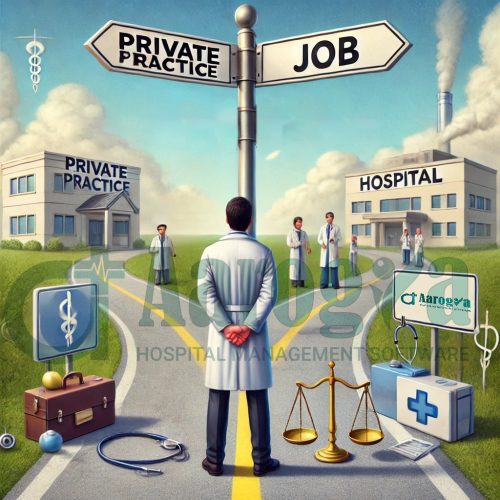
Opening a healthcare-related business whether it’s a clinic, a diagnostic lab, a hospital, or a pharmacy or Pursuing a Job presents unique challenges that depend on factors such as capital investment, regulations, competition, and operational requirements. We are providing you a detailed comparative analysis of these challenges.
Starting Your Own Practice (Private Practice)
Challenges:
1. High Start-up Costs: Opening a practice involves significant upfront investment in office space, equipment, licensing, and staff.
Solution: Seek financial support through small business loans, grants, or partnerships with other doctors to share costs.
2. Administrative Burden: Running a practice can be challenging because it includes managing billing, insurance, compliance, and staff.
Solution: Invest in practice management software and hire a competent office manager to handle administrative tasks.
3. Risk and Uncertainty: A new practice may take time to become profitable, and there’s the risk of failure.
Solution: Develop a strong business plan, focus on marketing, and gradually build a loyal patient base to reduce financial risks.
Benefits:
- Greater earning potential as the owner
- Full control over your practice’s direction and patient care
- Flexibility in your schedule
1. Opening a Clinic
A medical clinic is typically the most accessible healthcare business for a first-generation doctor, but it still requires overcoming several barriers.
Challenges:
- Location: Selecting the right location for a clinic can be difficult. It must be accessible to the target patient and in an area with sufficient demand for the type of services offered.
- Competition: Clinics compete with other medical professionals, hospitals, and local health centers. The market may already be controlled by well-known doctors or large healthcare networks.
- Regulatory Compliance: Navigating local health regulations, obtaining licenses, and following medical practice laws can be a hurdle for newcomers.
- Cost: Initial costs may be lower compared to labs or hospitals, but still major especially for medical equipment, office space, and staff salaries.
Solutions:
Partnership : As a doctor you can partner with more experienced doctors in the fields that are directly related to you. For eg. As a pediatrician you can partner with a Gynecologist. Physiotherapists can partner up with Orthopedic surgeons.
Symbiotic relation of doctors :
1. Cardiologist and Endocrinologist
Diabetes prevalence is expected to reach 73.5 million cases by 2025 according to PWC highlights the growing burden of chronic diseases and the increasing demand for endocrinologists and related specialists.
2. Oncologist and Radiologist
Based on a McKinsey report on healthcare strategies, the demand for specialists like cardiologists and oncologists is expected to rise by 40% due to the growing prevalence of non-communicable diseases (NCDs).
3. Dermatologist and Plastic Surgeon
Dermatologists treat skin conditions and plastic surgeons perform surgeries to improve appearance.Together they provide complete care for skin,health and aesthetics.
4. Nephrologist and Urologist
Nephrologists focus on kidney health, while urologists address urinary tract conditions. They collaborate to treat complex issues like kidney stones and urinary tract issues.
5. Psychiatrist and Psychologist
- Location Selection: Choosing the right location for a clinic is crucial for the success of any healthcare practice, Choose location with High Foot Traffic, Affordable Rent, Proximity to Residential Areas, Near Hospitals or Medical Centers
(1.) Understand Local Regulations
Research specific licenses, permits, and certifications required.
Certifications and Accreditations required to open a Clinic in India
| License Name | Why It’s Important | Examples |
|---|---|---|
| Clinic Registration Certificate | Ensures legal standards for safety and quality. | A general healthcare clinic in Bengaluru. |
| Doctor’s License | Legally allows doctors to treat patients. | An ENT specialist registered with the Medical Council of India. |
| Trade License | Permits a clinic to operate as a business. | Private clinic operating in Delhi. |
(2.) Seek Legal and Professional Advice
- Hire a healthcare lawyer or consultant to help navigate legal requirements.
- Consult with experienced clinic owners or mentors to understand common pitfalls.
(3.) Use Compliance Software
Investing in healthcare-compliant software, like Aarogya DM Aarogya, is vital for efficiently managing documentation, audits, and deadlines, especially when opening a clinic in India. With the introduction of the Ayushman Bharat Digital Mission ABDM digital integration has become central to modern healthcare management. Such software ensures compliance with ABDM guidelines, streamlining patient recordkeeping, telemedicine, and coordination with the national healthcare system.
2. Opening a Lab (Diagnostic Centre)
A diagnostic lab requires specialized medical knowledge, equipment, and adherence to regulatory standards, making it more complex than opening a clinic.
Challenges:
- High Initial Investment: Diagnostic equipment (such as MRI, X-ray machines, blood analysers, etc) are very costly. Renting or purchasing the required space is also expensive.
- Regulatory Hurdles: Labs are subjected to strict regulations, including accreditation (e.g., NABL in India) and compliance with health standards.
- Staffing: Labs require specialized staff, including technicians and qualified lab professionals. Recruiting skilled personnel can be challenging, particularly in areas with a shortage of qualified workers.
Solutions:
Certifications and Accreditations required to open Laboratory in India
| Certification/Accreditation | Purpose |
|---|---|
| FSSAI License | Ensures compliance with food safety and laboratory hygiene standards. |
| Drugs License (for handling diagnostic reagents) | Required for the sale and distribution of diagnostic reagents and chemicals. |
| Biomedical Waste Management Authorization | Ensures proper handling, disposal, and management of biomedical waste. |
- Implement Standard Operating Procedures (SOPs): Develop clear SOPs for testing, safety, and waste management to maintain compliance and quality.
- Maintenance Contracts: Sign maintenance contracts with equipment providers to ensure timely repairs and updates.
- Adopt Laboratory Management Software: Use software to streamline operations, manage test results, and reduce human errors.
3. Opening a hospital
Opening a hospital is one of the toughest tasks in healthcare. It requires extensive planning, large-scale financing, and considerable administrative expertise.
Challenges:
- Capital Investment: The costs of land, construction, medical equipment, and facilities are extremely high. The required investment for starting a hospital often runs into millions of dollars.
- Regulatory Approvals: Hospitals are subject to a wide range of regulations, including safety codes, staffing requirements, and accreditation standards (e.g. JCI). Obtaining the necessary licenses can take a long time.
- Staffing: Recruiting a wide range of medical professionals (doctors, nurses, administrative staff, etc.) and ensuring they meet quality standards is a challenge, especially in competitive healthcare markets.
Solutions:
Navigating Regulatory Compliance
Obtain Necessary Certifications and Accreditations:
Certifications and Accreditations required to open a hospital in India
| Certification/Accreditation | Purpose |
|---|---|
| NABH Accreditation | Ensures high standards of patient care, safety, and management. |
| Clinical Establishment Registration | Legally registers the hospital under the Clinical Establishments Act. |
| ISO Certification | Demonstrates adherence to quality management systems and standards. |
Ongoing Staff Training: Continuous staff training on compliance, patient care, safety, and regulations with nursing agencies involvement.
Securing Funding and Managing High Initial Costs: Explore government healthcare grants, loans, and partner with TPAs for infrastructure and hospital development.
Hospital Management Software: Utilize Hospital Management Software to streamline operations, supporting first-generation doctors in building efficient hospitals.
4. Opening a Pharmacy
Opening a pharmacy can be a profitable business with lower start-up costs compared to clinics, labs, or hospitals. However, pharmacies still face several important challenges.
Challenges: Regulatory Compliance
- Financial and Funding Challenges: Opening a pharmacy requires substantial upfront investment in inventory, equipment, and licensing. First-generation doctors may struggle to secure funding or have limited access to financial networks
- Building a Customer Base and Reputation: As a first-generation doctor opening a pharmacy, you may not have a built-in customer base, making it difficult to attract patients and establish trust in a competitive market.
Solutions:1. Regulatory Compliance
Licenses required to open a pharmacy in India
| License Name | Purpose |
|---|---|
| Drug License | Permits the sale, storage, and distribution of medicines legally. |
| GST Registration | Ensures compliance with tax regulations and facilitates proper billing |
| Trade License | Allows the business to operate legally and safely. |
- Train Your Team: Make sure your staff understands and follows laws about medication safety and patient privacy.
- Use Software: Invest in pharmacy software that helps you manage prescriptions and keep track of inventory while staying compliant with laws.
Simplify managing prescriptions, tracking inventory, and staying compliant with Aarogya’s Pharmacy Software DM Aarogya
2. Financial and Funding Challenges
- Look for Loans or Grants: Search for government loans or grants that can help you start your pharmacy.
- Partner Up: Consider teaming up with other businesses or suppliers to share costs and reduce risks.
3. Building a Customer Base and Reputation
- Get Involved Locally: Attend community events, offer free health checks, or talk to people in the area to let them know about your pharmacy.
- Your brand in OPD decides your Pharmacy.
- Offer Great Service: Provide excellent customer service, like delivering medications or offering advice, so customers trust you and keep coming back.
- Use Online Marketing: Integrate with ONDC to expand your pharmacy’s reach and connect with a wider audience across multiple platforms.
Pursuing a Job (Working for a Hospital or Clinic)
Challenges:
1. Limited Autonomy: Working for an employer means you are following the organization’s policies and procedures, which can limit your decision-making power.
Solution: Focus on roles that allow for some level of leadership or influence, such as department head or supervisor positions.
2. Lower Earning Potential: Salaries are often fixed, which may not offer the same growth potential as owning a practice.
Solution: Look for opportunities to work in high-demand specialties or in regions with physician shortages to maximize income.
3. Enhancing Medical Practice Through Mentorship: Doctors get limited hands-on Practice/ Direct Interactions with the patients since the Reputed Organisations have their own set of Doctors/HODs and protocols in place. So the medical practice of the Doctor has a slower learning curve.
Solution : Maintain a student mentor relationship with the HODs and higher level doctor authorities.
Benefits:
- Job security with a steady income
- Less financial risk
- Opportunity for professional development and mentorship.
Which Option is Best for you?
Ultimately, the choice depends on individual preferences, financial situation, and long-term goals. Here’s a quick breakdown: Pursuing a Job may be ideal if you prefer job security, a structured environment, and fixed income, especially if you’re new to the medical field or if you want to focus on patient care without the burden of running a business. Starting Your Own Practice could be the best choice if you’re entrepreneurial, have a passion for independence, and are willing to take on the financial and administrative challenges in exchange for higher earning potential and more control over your work life. As a first generation doctor, starting with a job might be a safer option to build experience, financial stability, and confidence before entering into private practice. However, if you have the sufficient resources and budget, your own practice could be a fulfilling long-term goal.
FAQ’S
1. What are the biggest challenges faced by first-generation doctors?
First-generation doctors often face unique challenges such as financial constraints, regulatory compliance, limited business knowledge, building patient trust, attracting skilled staff, managing operations, and balancing clinical and business responsibilities.
2. How can first-generation doctors overcome financial barriers when starting their practice?
To overcome financial barriers, first-generation doctors can explore options such as small business loans, grants, and government programs. Additionally, partnering with other doctors, seeking financial advisors, and leveraging practice management software to reduce overhead costs can be helpful.
References
You can also refer
- Times of India
- National Medical Commission (NMC): Offers insights into policies and systemic barriers in Indian medical education. Visit NMC
- Public Health Foundation of India (PHFI): Discusses access, equity, and challenges in healthcare education. Visit PHFI
- AIIMS Research Publications: Highlights challenges in medical education and systemic gaps for underrepresented students. Visit AIIMS
- National Informatics Centre (NIC): Features government policies addressing challenges in medical education. Visit MoHFW
- Educational Research by NCERT: Examines barriers faced by first-generation learners in professional fields. You can explore their publications section for related studies or contact them directly through their official site: NCERT
